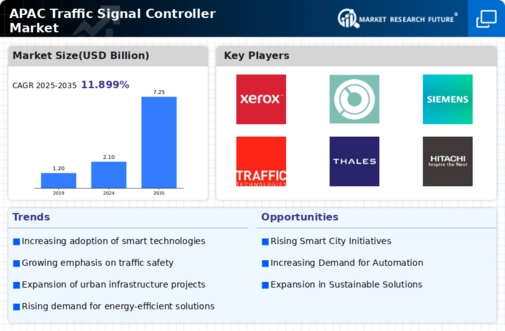The APAC Traffic Signal Controller Market is characterized by rapid technological advancements and increasing demand for smart traffic management solutions. As urban populations continue to grow, the essentiality of efficient traffic control systems becomes more pronounced, leading to heightened competition among various industry players. The market features a diverse array of offerings, including traditional signal controllers, intelligent traffic signal systems, and integrated solutions that leverage artificial intelligence and IoT technology. With government initiatives promoting smart city developments across the region, the competitive landscape is evolving, with established companies vying for market share alongside emerging firms.
This dynamic environment fosters innovation and influences pricing strategies as firms develop advanced features to meet the varying needs of urban centers.
Focusing on Xerox within the APAC Traffic Signal Controller Market, the company's commitment to innovation stands out as a core strength. Xerox has been actively expanding its presence in the region by enhancing its product lineup to include state-of-the-art traffic control systems that improve traffic flow and reduce congestion. The company's ability to integrate cutting-edge technology with user-friendly interfaces has positioned it favorably among municipal agencies seeking efficient and reliable solutions.
Additionally, Xerox leverages its strong brand reputation and extensive experience in document management to facilitate partnerships and collaborations with local governments, paving the way for successful deployments and ongoing support. This strategic approach not only enhances their market presence but also establishes Xerox as a trusted collaborator in the development of smart infrastructure in the APAC region.
Civica is another key player in the APAC Traffic Signal Controller Market, renowned for its extensive portfolio of software solutions and services aimed at improving public administration and infrastructure efficiency. The company offers advanced traffic management systems that are designed to optimize traffic signals, thereby enhancing road safety and reducing travel times. Civica has managed to carve out a significant niche in the region by focusing on the integration of technology that allows for real-time data analytics and adaptive signal control. Their strengths lie in their robust technological foundation, enabling the development of customized solutions that address local challenges.
Moreover, Civica has been engaged in strategic mergers and acquisitions to bolster its capabilities, which has also contributed to its competitive edge. By continuously investing in research and development and establishing partnerships, Civica remains well-positioned to respond to the growing demands of cities striving for smart urban mobility solutions throughout the APAC region.






















Leave a Comment